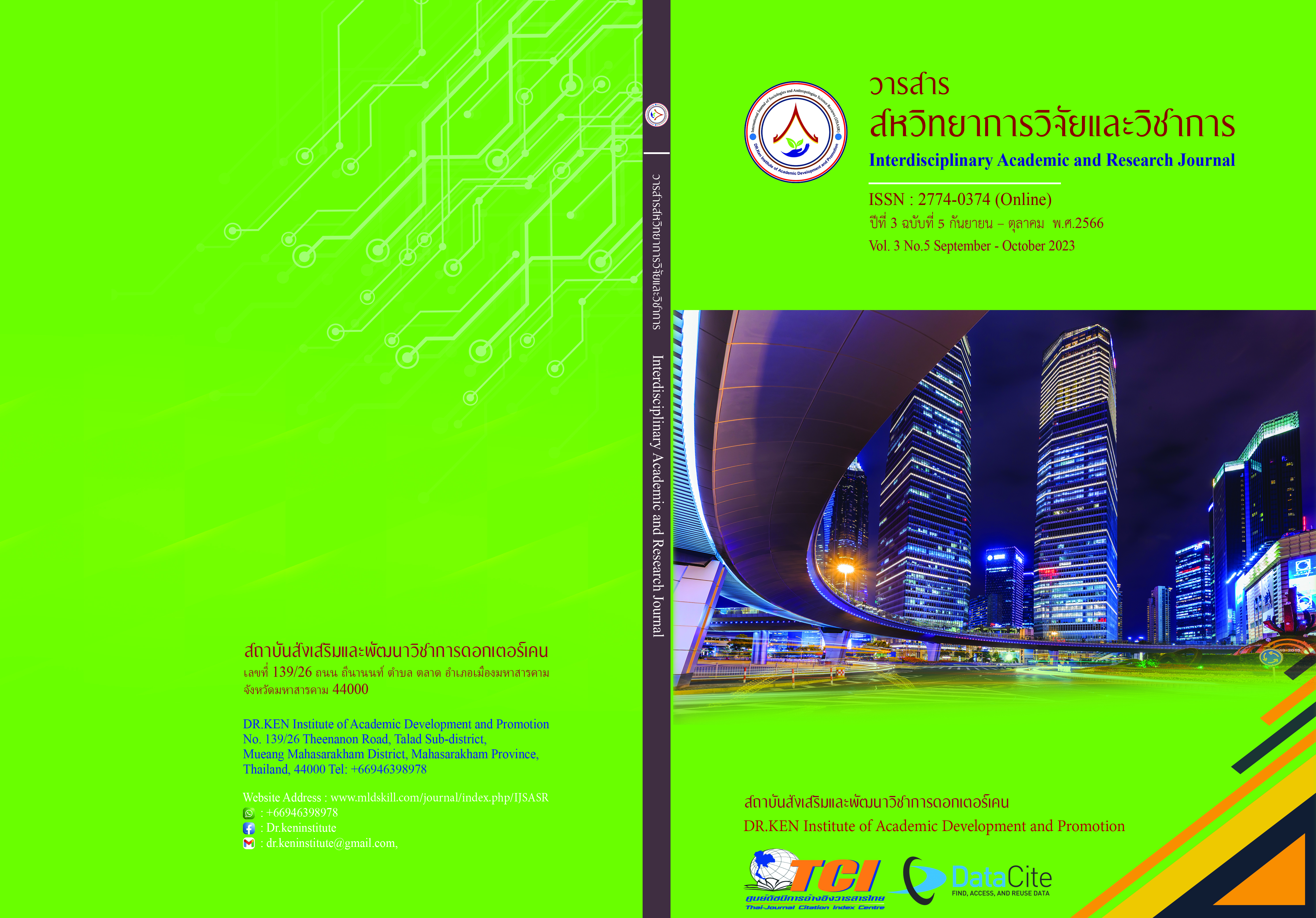The Construction of a Work Readiness Scale for Vocational Students
DOI:
https://doi.org/10.14456/iarj.2023.255Keywords:
Work Readiness; , Vocational Students; , Readiness ScaleAbstract
Work readiness is the capacity or potential of private vocational students to work or perform tasks in the future successfully and achieve their goals. In order to determine how readily students are and at what level they are ready, it is necessary to have tools to measure and assess student readiness. Thus, in this thesis, the researcher constructs and determines (1) the quality of a work readiness scale for vocational students; and constructs (2) the criteria to interpret the meaning of the scores of the scale constructed. The sample used in the research was 1,145 private vocational students in Rayong Province. The research instrument was a work readiness scale for vocational students measuring four components based on the concept of Caballero consisting of personal attributes; organizational knowledge and understanding; work capability; and social intelligence. The quality analysis of a work readiness scale for vocational students using the content validity, the index of item-objective congruence (IOC), and the construct validity by comparing scores between groups using the independent samples t-test, and the validity of the whole scale was 0.970 and each component at 0.896-0.981 using Cronbach’s alpha coefficient. The criteria to interpret the score meaning was constructed using the t-score. The levels were divided based on the concepts of Clark-Carter.The results showed that the construct validity using the known intergroup score comparison method, there is evidence to support construct validity of the work readiness test (t=-4.831,p=0.000) and the result of criteria to interpret score meaning, the scale has t-score ranging from T16.72 to T74.81 (P0.05 – P99.34), work readiness is high level with t-score ranging from T56.78 and above, relatively high level with t-score ranging from T50.23 to T56.44, relatively low level with t-score ranging from T43.57 to T49.93 and low level with t-score less than T43.57.
References
ชาญณรงค์ ลักษณียนาวิน. (2558). การพัฒนาโลกเสมือนเพื่อเสริมสร้างทักษะที่จำเป็นของนักศึกษาอาชีวศึกษา. วิทยานิพนธ์ปริญญาครุศาสตรดุษฎีบัณฑิต: มหาวิทยาลัยจุฬาลงกรณ์.
ปิยะธิดา วรญาโณปกรณ์. (2563). การพัฒนาตัวบ่งชี้และแนวทางการส่งเสริมจิตสาธารณะสำหรับนักเรียน ระดับมัธยมศึกษาตอนต้นในเขตภาคตะวันออก. ดุษฎีนิพนธ์ปรัชญาดุษฎีบัณฑิต: มหาวิทยาลัยบูรพา.
มนัญญา หาญอาสา. (2560). การพัฒนาแบบวัดพฤติกรรมการติดอินเตอร์เน็ตสำหรับนักเรียนชั้นมัธยมศึกษาตอนต้น โรงเรียนในสังกัดสำนักงานเขตพื้นที่การศึกษามัธยมศึกษาเขต 18. วิทยานิพนธ์วิทยาศาสตรมหาบัณฑิต: มหาวิทยาลัยบูรพา.
รัชพล กลัดชื่น และจรัญ แสนราช. (2562). การวิเคราะห์องค์ประกอบเชิงสำรวจความพึงพอใจของสถานประกอบการที่มีต่อนักศึกษาฝึกทักษะวิชาชีพระดับประกาศนียบัตรวิชาชีพชั้นสูง. วารสารวไลยอลงกรณ์ปริทัศน์, 9(1), 47-55.
ศิริชัย กาญจนวาสี. (2556) ทฤษฎีการทดสอบแบบดั้งเดิม. พิมพ์ครั้งที่ 7. โรงพิมพ์จุฬาลงกรณ์มหาวิทยาลัย.
ศูนย์เทคโนโลยีสารสนเทศและกำลังคนอาชีวศึกษา. (2565). ข้อมูลนักเรียนนักศึกษา ปีการศึกษา 2565 สถานศึกษารัฐ และเอกชน รายสถานศึกษาจำแนกตามประเภทวิชา สาขาวิชา สาขางาน. Retrieved from: https://techno.vec.go.th
สมนึก ภัททิยธนี. (2553). การวัดผลการศึกษา. พิมพ์ครั้งที่ 7. โรงพิมพ์ประสานการพิมพ์.
สำนักงานคณะกรรมการการอาชีวศึกษา. (2553). สถิติข้อมูลการศึกษาของสำนักงานคณะกรรมการการอาชีวศึกษา. Retrieved from: http://techno.vec.go.th
สำนักงานคณะกรรมการการอาชีวศึกษา. (2560). แผนพัฒนาการอาชีวศึกษา พ.ศ. 2560 – 2579. สำนักงานคณะกรรมการการอาชีวศึกษา.
สำนักงานคณะกรรมการการอาชีวศึกษา. (2562). หลักเกณฑ์และแนวปฏิบัติการจัดการอาชีวศึกษาระดับประกาศนียบัตรวิชาชีพและระดับประกาศนียบัตรวิชาชีพชั้นสูง. วิทยาลัยเทคนิคมีนบุรี.
สุกัญญา พรน้อย. (2562). การพัฒนาตัวบ่งชี้ความปลอดภัยในโรงเรียนประถมศึกษาสังกัดสำนักงานคณะกรรมการการศึกษาขั้นพื้นฐาน. ดุษฎีนิพนธ์ปรัชญาดุษฎีบัณฑิต: มหาวิทยาลัยบูรพา.
สุวิมล ติรกานันท์. (2551). การสร้างเครื่องมือวัดตัวแปรในการวิจัยทางสังคมศาสตร์:แนวทางสู่การปฏิบัติ. พิมพ์ครั้งที่ 2. โรงพิมพ์จุฬาลงกรณ์มหาวิทยาลัย.
Caballero, C. L., Walker, A., & Fuller-Tyszkiewicz, M. (2011). The Work Readiness Scale (WRS): Developing a measure to assess work readiness in college graduates. Journal of Teaching and Learning for Graduate Employability, 2(1), 41-54.
Clark‐Carter, D. (2005). Percentiles. Encyclopedia of statistics in behavioral science.
Irwansyah, M. R., Meitriana, M. A., & Suwena, K. R. (2020). Student Work Readiness in Vocational High School. In 5th International Conference on Tourism, Economics, Accounting, Management and Social Science (TEAMS 2020) (pp. 285-290). Atlantis Press.
Ridho, A., & Siswanti, A. D. (2020). Future perspective and work readiness on students. Journal psikologi, 19(2), 201-211.10.14710/jp.19.2.201-210.
Yamane, T. (1973). Statistics: An Introductory Analysis. 3rd Edition, Harper and Row: New York.
Downloads
Published
How to Cite
Issue
Section
License
Copyright (c) 2023 Marisa Paenmeon, Panida Panidvadtana, Kamaontip Srihaset

This work is licensed under a Creative Commons Attribution-NonCommercial-NoDerivatives 4.0 International License.
Copyright on any article in the Interdisciplinary Academic and Research Journal is retained by the author(s) under the under the Creative Commons Attribution-NonCommercial-NoDerivatives 4.0 International License. Permission to use text, content, images, etc. of publication. Any user to read, download, copy, distribute, print, search, or link to the full texts of articles, crawl them for indexing, pass them as data to software, or use them for any other lawful purpose. But do not use it for commercial use or with the intent to benefit any business.
















.png)


